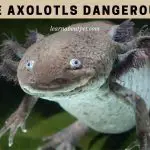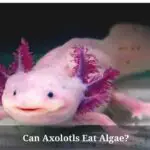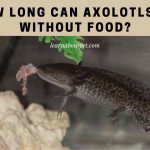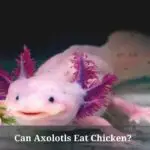It can be rather disturbing for an axolotl owner to discover that their axolotl seems to be getting fat. Under those circumstances, one will want to know whether axolotls can get fat, and if yes, what may cause them to get fat, and what to do about it. This article answers all those questions.
If you have a genuinely fat axolotl, it may be due to overfeeding. But the fat appearance may also be on account of illness, gas trapped inside its body or it having ingested some foreign body(ies). And if it is a female axolotl, the fat appearance may be due to eggs in her stomach.
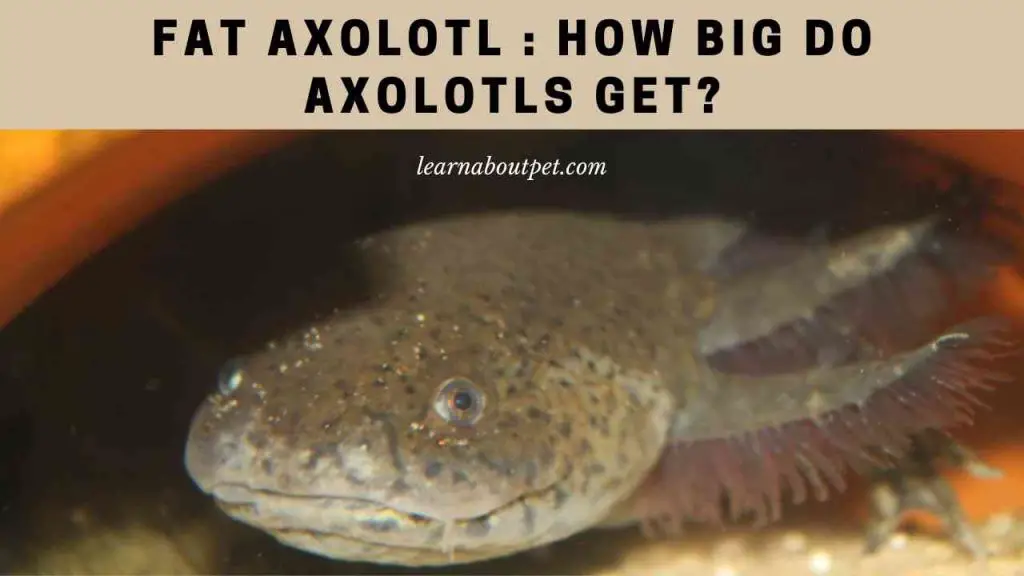
How Big Do Axolotls Get?
In order to be in a position to know whether or not you really have a fat axolotl, it is important to first understand how big axolotls get.
You would otherwise have no basis for calling an axolotl fat, in the absence of information on how big axolotls normally get.
So, indeed, how big do axolotls get? The answer is that axolotls can get as big as 18 inches long. They typically grow to the 8 to 10 inches range though.
Very rarely would an axolotl grow past 12 inches.
In terms of width, axolotls don’t get too wide. A healthy axolotl will normally have a belly whose width is roughly the same as its head.
Therefore if, for instance, you have an axolotl whose stomach is considerably wider than its head, then you may have a really fat Axolotl. Chances are that it would also be an overweight axolotl or even an obese axolotl.
This is indeed why, if you were to look at a typical fat axolotl drawing, you would see it depicting a stomach that is much wider than the head. And this is the case, even if what is under consideration is a dwarf fat axolotl…
Note that the focus here is on the stomach region. This is because you are very unlikely to get a fat head axolotl. Axolotl body fat normally goes to the mid region, hence this situation.
So what we normally see is an axolotl fat belly: not an axolotl that is fat in the upper (head) region.
How Much Do Axolotls Weigh?
Another key thing you need to have insight into, before starting to fear that your axolotl is too fat, is the typical weight for axolotls.
As it turns out, the weights of axolotls are normally in the 60 grams to 300 grams range.
Most axolotls will normally fall somewhere between 100 grams and 250 grams.
If you have an axolotl that is more than 300 grams, then indeed it may be overweight.
What Does A Healthy Axolotl Look Like?
If you suspect that your axolotl is fat (or you just feel that your axolotl looks fat), you will probably want to know what a healthy axolotl looks like.
As it turns out, a healthy axolotl will typically have reasonably big gills (that are not undergoing shrinkage), eyes in its sockets (not popping out) and reasonably straight tail (without upward curvature).
Its stomach size should also be normal: roughly the same width as its head, without bloating.
Can Axolotls Be Fat?
One of the first questions posed by people who suspect that their axolotls are too fat is this one: on whether axolotls can actually be fat.
So, indeed, can axolotls get fat? The answer is ‘yes’. It is possible for axolotls to be fat. Many axolotl owners have reported instances of their axies being fat.
And going by the number of fat axolotl Reddit threads, it seems that the whole thing is plausible.
Of course, many instances where people think that their axolotls are fat turn out to be other things. For instance, an axolotl that has gotten swollen due to disease may look fat.
Similarly, a female axolotl that is heavy with eggs may look fat.
And an axolotl that has ingested foreign objects may also look fat.
Such axolotls may look fat without being fat in the real sense of the word.
All in all though, there are also cases where axolotls turn out to be fat in the real sense.
Can Axolotls Overeat?
People normally associate being fat with overeating. Therefore the inference is that the axolotls that are fat are likely to be overeating. But that leads to an interesting question: on whether axolotls can overeat, in the first place.
Whether axolotls can overeat really depends on their age.
For juvenile axolotls, overfeeding is almost impossible. This is because they normally have a mechanism through which they regurgitate any excess food they eat.
But for adult axolotls, things seem to be different. Some of them will still regurgitate excess food. Others will continue eating, in spite of being full: often leading to problems like impaction.
Still, it is important to understand that when we talk of axolotls regurgitating ‘excess’ food, it is only within the context of excess food that their bodies can’t digest.
But there are cases where what you are feeding the axolotl may not reach the threshold of being indigestible. Yet it is still beyond the axolotl’s nutritional requirements.
So you may not be overfeeding the axolotl in the sense of giving it more food than it can digest. In that case, it would simply regurgitate the food.
But you may be giving the axolotl more food that it really needs. Therefore you end up with an axolotl getting fat. That may in due course become an obese axolotl.
It can also be a case where you are giving too much fat food for axolotl. Or you may even be (unknowingly) feeding the axolotl on too much fat directly.
Here, someone may ask, can axolotls eat fat? And the answer is ‘yes’ – if the fat is part of treats like the various worms the axolotls eat.
Why Is My Axolotl Fat?
In answering this question, we first need to find out, how fat should an axolotl be? Once you have the general guideline, you can go further and start asking, is my axolotl too fat?
Now as it turns out, an axolotl should have a belly region that is roughly the same width as its head.
Therefore if you have an axolotl whose stomach is much wider than its head, it may be cause for concern. There may even be reason for you to ask, why is my axolotl so fat?
Or if it is a new phenomenon, you may have a reason to ask, why is my axolotl getting fat?
Now in a scenario where my axolotl has been getting fat, the first thing to consider would be the feeding patterns. So one possibility is that I may have been overfeeding the axolotl. Therefore it eventually becomes overweight.
In this context, ‘overfeeding’ may mean giving the axolotl food daily. Yet if it is an adult axolotl, it should only get food like twice or thrice per week.

Sometimes, you may even have someone feeding their axolotl three times a day, like a human! That is only something you should do if you want to get the record for having the fattest axolotl in the world.
In other words, that is how to fatten up an axolotl.
But even if you find a fat axolotl cute, you should know that the excess weight is likely to impact its health negatively… That is why trying to learn how to fatten up axolotl is really not a worthy pursuit.
All in all, one possible reason for the axolotl being fat is overfeeding.
Other possible reasons are disease, impaction and the axolotl (if female) being heavy with eggs.
Disease, Impaction And Being Heavy With Eggs
What looks like a fat axolotl may in fact be suffering from something like fluid retention. This may be due to kidney problems or something else. So the axolotl looks fat when in fact it isn’t.
Further, what looks like a fat axolotl may in actual fact have eaten some foreign objects, leading to impaction. Or it may have eaten more than it can digest, leading to impaction.
At yet another level, what looks like a fat axolotl may in fact turn out to be a female whose belly is swollen up with eggs.
You therefore need to rule out these possibilities, before thinking that your axolotl is actually fat.
My Axolotl Is Fat – What To Do?
Firstly, you need to be sure that the axolotl is truly fat. You need to be sure that it is not suffering from some disease or impaction. And that it is not swollen with eggs, if it is female.
Upon ruling out those things, you need to review your axolotl feeding patterns. Ensure that you are not giving the axolotl too much food. And that you are not giving it food that is too rich too often. And further that you are not feeding it too frequently.
Baby axolotls can eat once per day. Juvenile axolotls can eat every other day. But adult axolotls are best fed twice or (max) thrice per week. Otherwise they may become overweight.
You may also consider giving the axolotl live food that it can chase around in its tank, before catching it. The idea here would be to get the axolotl to ‘exercise’ a bit.
Final Verdict – Fat Axolotl
Ideally, an axolotl’s belly should be roughly the same width as its head. If you have an axolotl whose stomach region is much wider than its head, it may indeed be fat.
Then again, before coming to the conclusion that your axolotl is fat, you need to rule out other possibilities. The axolotl may be swollen from some disease or from impaction (like, for instance, after eating foreign bodies). And if it is female, it may be swollen with eggs.

Where the axolotl seems to be genuinely fat, and you have ruled out those other possibilities, what you may need to do is change your feeding patterns.
And where the problem seems to be inexplicable, it may be best to take the axolotl to an exotic pets vet for examination, diagnosis and advice on the best way forward.
As a pet lover, make sure to learn about pet more and give your pet axolotl a good and comfortable life!

Welcome to Learn About Pet. My name is Rajkumar Ravichandran and I love all pets, travel, and amazing food. I write about my passion and personal experience caring for multiple pets in this blog! ❤️
Post Disclaimer
DISCLAIMER: THIS BLOG OR WEBSITE, "Learn About Pet", DOES NOT PROVIDE YOU WITH MEDICAL ADVICE AND IS NOT A SUBSTITUTE FOR MEDICAL ADVICE. ALWAYS GET IN TOUCH WITH YOUR PERSONAL VETERINARIAN AND USE INFORMATION HERE AS GENERAL ADVICE.
The information, including but not limited to, text, graphics, images and other material contained on this website are for informational purposes only. No material on this site is intended to be a substitute for professional veterinary advice, food recommendation, diagnosis, or treatment. Always seek the advice of your veterinarian or other qualified health care provider with any questions you may have regarding a medical condition or for pet food related questions.



